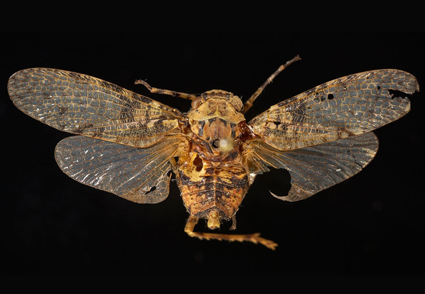Abstract
The fulgorid name Alphina glauca (Metcalf) has been used erroneously since its inception to refer to a primarily southeastern U.S. species described originally as Calyptoproctus marmoratus Spinola. Additionally, at least three undescribed species from the Southwest have been incorrectly identified as A. glauca. The holotype of A. glauca has not been located. Since A. glauca is presently used to refer to multiple species, a neotype is designated which places A. glauca into synonymy with Calyptoproctus marmoratus. We establish a new genus, Scaralina, into which it is placed, giving the new combination Scaralina marmorata (Spinola), along with three southwestern, one Texan, and ten Mesoamerican taxa, named here as new species: S. aethrinsula, S. chapina, S. cristata, S. durango, S. gigantea, S. hawksi, S. metcalfi, S. monzoni, S. obfusca, S. obrienae, S. orientalis, S. rileyi, S. sullivani, and S. veracruzensis. Additionally, one new species of Scaralis in a new subgenus, Scaralis (Alphinoides) inbio, is described from Costa Rica and Guatemala. The limited information available suggests these insects feed on oaks (Quercus). The single defining putative synapomorphy for the subtribe Calyptoproctina is the enlarged apical plate on the female abdomen, which is absent in at least two members of Scaralina, and is also present in some genera that belong outside of Poiocerinae, so we reject the recognition of this subtribe. We consider that Scaralina is probably more closely related to the genus Scaralis Stål than to Alphina Stål. Based on morphology, some species originally described in Scaralis appear to be more closely related to one another than to the type species of the genus, and are here placed in a new subgenus, Alphinoides; Scaralis fluvialis Lallemand and Scaralis nigronotata Stål, plus three species originally described in Poiocera; Scaralis quadricolor (Walker) (the type species of Alphinoides), Scaralis semilimpida (Walker), and Scaralis spectabilis (Walker). Diagnoses are given for separation of the genera Scaralis and Scaralina, as well as the subgenus Alphinoides, plus descriptions of and keys to all species of Scaralina north of Panama, as well as keys to the genera corresponding to the former subtribe “Calyptoproctina” occurring north of Panama.
References
- Ball, E.D. (1933) Notes on the Fulgoridae with some new species. Psyche, 40, 145–154.
- Bartlett, C.R., O’Brien, L.B. & Wilson, S.W. (2014) A review of the planthoppers (Hemiptera: Fulgoroidea) of the United States. Memoirs of the American Entomological Society, 50, 1–287.
- Bourgoin, T., Wang, R.R., Asche, M., Hoch, H., Soulier-Perkins, A., Stroiński, A., Yap, S. & Szwedo, J. (2015) From micropterism to hyperpterism: recognition strategy and standardized homology-driven terminology of the forewing venation patterns in planthoppers (Hemiptera: Fulgoromorpha). Zoomorphology, 134, 63–77.
- Distant, W.L. (1887) Insecta, Rhynchota. Hemiptera-Homoptera. Vol. I. In: Godman, F.D. & Salvin, O. (Eds.), Biologia Centrali-Americana. Taylor & Francis, London, pp. 169–224, pls. xvi–xix.
- Dozier, H.L. (1928) The Fulgoridae or planthoppers of Mississippi, including those of possible occurrence. Technical Bulletin of the Mississippi Agricultural Experiment Station, 14, 1–152.
- Gómez-Marco, F., Yanega, D., Ruiz, M. & Hoddle, M.S. (2023) Proactive classical biological control of Lycorma delicatula (Hemiptera: Fulgoridae) in California (US): Host range testing of Anastatus orientalis (Hymenoptera: Eupelmidae). Frontiers in Insect Science, 3, 1–19.
- Hipp, A.L., Manos, P.S., González-Rodríguez, A., Hahn, M., Kaproth, M., McVay, J.D., Avalos, S.V. & Cavender-Bares, J. (2018) Sympatric parallel diversification of major oak clades in the Americas and the origins of Mexican species diversity. New Phytologist, 217, 439–452.
- ICZN (1999) International Code of Zoological Nomenclature. 4th Edition. International Trust for Zoological Nomenclature, London, xxix + 306 pp.
- Lallemand, V. (1956) Contribution a l’etude des Fulgoridae (Hemiptera) (lre Note). Institut royal des Sciences naturelles de Belgique, Bulletin, 32 (39), 1–7.
- Metcalf, Z.P. (1923) A key to the Fulgoridae of eastern North America with descriptions of new species. Journal of the Elisha Mitchell Scientific Society, 38 (3), 139–230.
- Metcalf, Z.P. (1938) The Fulgorina of Barro Colorado and other parts of Panama. Bulletin of the Museum of Comparative Zoology at Harvard College, 83 (5), 277–423.
- Metcalf, Z.P. (1947) General Catalogue of the Hemiptera. Fascicle IV. Fulgoroidea. Part 9. Fulgoridae. Smith College, Northampton, Massachusetts, 276 pp.
- Porion, T. (1994) Fulgoridae 1. Catalogue illustré de la faune. Sciences Nat, Venette, France. 71 pp., 16 pls.
- Robacker, D.C., Hawks, D.C., Castillo, N. & Miranda, B. (2022) A new species of Chrysina Kirby (Coleoptera: Scarabaeidae: Rutelinae) from the Sierra Madre Occidental of Mexico, with notes on the type locality of Chrysina adelaida (Hope, 1841). Insecta Mundi, 955, 1–14.
- Seidel, S. & Wessel, A. (2013) On the morphology and preparation of male genitalia in the Fulgoridae - The Southeast Asian genus Penthicodes (Hemiptera, Fulgoromorpha, Fulgoridae). Deutsche Entomologische Zeitschrift, 60 (2), 193–207.
- Spinola, M. (1839) Essai sur les Fulgorelles, sous-tribu de la tribu des Cicadaires, ordre des Rhyngotes. Annales de la Societe Entomologique de France, 8, 133–337.
- Stål, C. (1863) Beitrag zur Kenntniss der Fulgoriden. Entomologische Zeitung, 24, 230–251.
- Urban, J.M. & Cryan, J.R. (2009) Entomologically famous, evolutionarily unexplored: The first phylogeny of the lanternfly family Fulgoridae (Insecta: Hemiptera: Fulgoroidea). Molecular Phylogenetics and Evolution, 50 (3), 471–484.
- Walker, F. (1851) List of the specimens of homopterous insects in the collection of the British Museum. Parts II & III. British Museum, London, pp. (4) + 261–536 & pp. (4) + 637–907.
- Walker, F. (1858) List of the specimens of homopterous insects in the collection of the British Museum. Supplement. British Museum, London, (4) + 369 pp.


